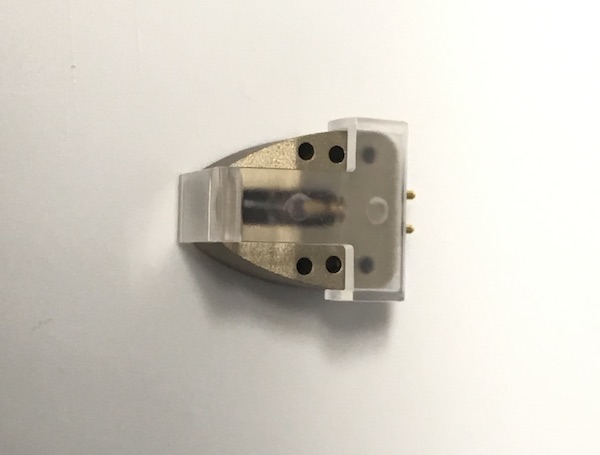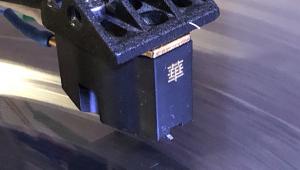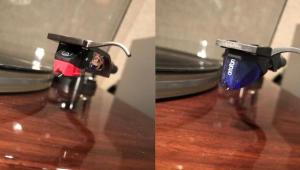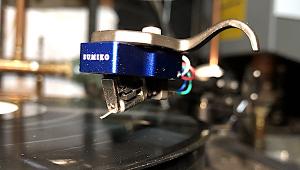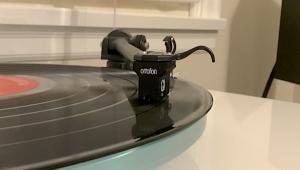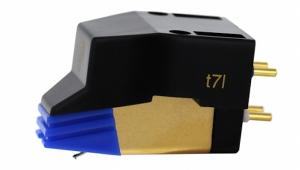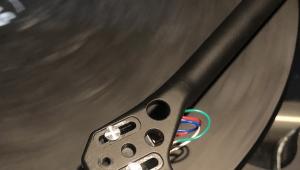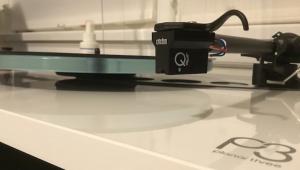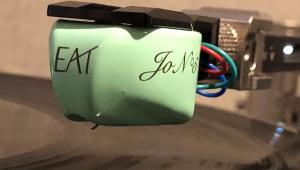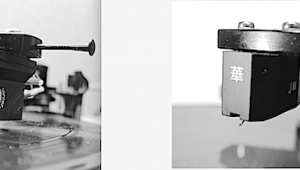... this cartridge have a boron cantilever and some variation of line-contact shape stylus?
With the Donatello Gold MC Cartridge Gold Note Plays “The Price Is Right” (Revised)
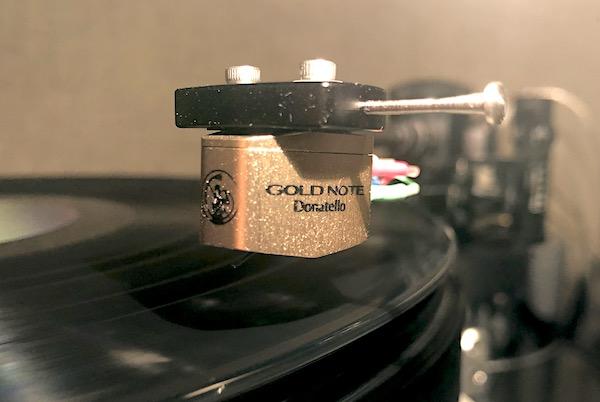
“Well, Michael, the Donatello Gold MC cartridge features a beautifully machined Duraluminum alloy (aluminum, copper, manganese, and magnesium) body and weighs in at 7 grams. It features an aluminum cantilever to which is attached a Micro-Elliptical stylus co-developed with Adamant-Namiki, outputs a generous 0.5mV, has a frequency response of 10-40,000Hz, and an internal impedance of 40 ohms. The coils are of copper, the magnet is Samarium-Cobalt. Compliance is rated at a usefully low 12x10-6cm/dyne, with suggested tracking force between 1.8 and 2.1 grams. Channel separation is realistically spec’d at 25dB with channel balance spec’d at <1dB.”
Thank you, and I’m sorry for calling you a “vacuous bimbette”. That is deeply offensive in 2019. Since I’m the only contestant on today’s “The Price Is Right”, I will make only one guesstimate as to the price of Gold Note’s Donatello Gold cartridge—and this is before listening or measuring anything.
Considering the aluminum body and elliptical stylus as well as the attractive packaging, my guesstimate is $1695. Assuming it measures and sounds as good as it looks, I’m going with that!
“Oh, sorry Michael, you’ve grossly overbid and lost today’s “The Price Is Right” How embarrassing for you! The actual list price of Gold Note’s Donatello Gold cartridge is $1070! Now, lift your dropped jaw from the floor, install the Donatello Gold , measure what you can and report back. You’ve thoroughly embarrassed yourself. Look who’s calling whom a ‘vacuous bimbette’!”
Installation, Measurements and Listening
How embarrassing! But you really can’t blame me for thinking the Donatello Gold cost more than $1500 before auditioning and especially afterwards! The cartridge is nicely packaged though Gold Note loses a few points for not providing a stylus guard, which means you have to be extremely careful installing it, and if you have cats, kids with poking fingers or incompetent cleaning people you will have to deal with that in your own way (a dustcover with skull and crossbones sticker, or a removable head shell on your tone arm or whatever).
Goldnote emailed: It Now Provides a Stylus Cover
I installed the Donatello Gold on the Graham Phantom III tonearm mounted on TechDAS’s least costly Air Force V turntable, though at $19,500 without arm it’s still pricey! Thus I was going to get maximum performance from the Donatello, but would it be playing in a too rich an environment and embarrass itself?
First off, the Donatello Gold—at least my sample—was very well manufactured and relatively easy to set up. With the arm parallel to the record surface, SRA measured close to 92 degrees. To maximize separation and minimize cross talk differences between the channels, I had to move the cantilever’s position ever so slightly from perpendicularity. It’s easy to do on the Graham. Using a digital oscilloscope I measured better than spec’d separation of 26dBs and achieved the spec’d within 1dB interchannel balance (and keep in mind the oscilloscope method usually shortchanges somewhat the separation figures, though it’s totally accurate in terms of the actual set-up). So far so good!
Before actually playing anything but based on the stylus profile, and the generous output and 40 ohm internal impedance, which means more coil turns and thus higher moving mass, rather than a powerful magnet system, my expectations were for a cartridge with reasonably good but not exceptional detail retrieval, moderate but not “lightning-fast” transient response and an overall pleasant sound. Given the Duralumin body, which usually means low resonant performance, I was expecting timbrally well-balanced sound.
What I got, running the cartridge into either the ultra-costly Ypsilon VPS-100 Silver phono preamp via a Ypsilon MC-10 step up transformer or the voltage amplification input of the CH Precision P1/X1 phono preamp (loaded at 500 ohms) was a cartridge that sonically performed well above its price point. Of course as expected it was not a “detail resolving” champ, nor the fastest kid on the block but its timbral balance was unerringly neutral and top-to-bottom well extended with no obvious tonal lumps or bumps. Transparency was also impressive.
The Donatello Gold tracked well and sailed easily through the 80µm peak on Ortofon’s test record. It handled vocal transients well, producing pleasing smoothness without notably over-softening and blurring detail.
What most impressed me about the Donatello was how much of a “set it up and forget about it” cartridge it turned out to be. I listened to it for way too long (don’t ask the manufacturer how long it took for me to get this review published once I’d unearthed the cartridge from among the boxes waiting to be opened) because the Donatello’s overall performance was so pleasing and “easy to forget” in the best sense of that expression.
While the Donatello Gold’s sound was on the opposite side of “hard and analytical” it was nevertheless, and regardless of musical material, never “soft and smothering”.
1996’s somewhat obscure MILES DAVIS Live Around the World (9362-46032-1)—an American released double LP set pressed at Warner’s Allsdorf Germany pressing plant—needs a good reissue. It’s late live Miles culled from analog and digital recordings done around the world between 1988 and 1991. It peaked at #4 on Billboard’s Jazz album chart and was heard by most people on CD. It’s even possible that this LP was sourced from a CD resolution master. Not everyone liked it, but I do! It’s worth owning just for the almost 10 minute cover of “Time After Time” recorded at the JVC Jazz Festival in Chicago June 5th 1989. 1989 sounds “recent” to me until I count and then it’s 30 forking years ago! In any case when I play it for people they love both what Miles does to the tune and the searing sound of his horn, which should bite and draw blood but not slice you open.
The worst sin a cartridge can commit on this recording is to soften the horn to “mellow”. While the Donatello Gold didn’t produce large puncture wounds and leave a red trail as the best cartridges can do (and you’ll enjoy it, trust me!), it did get well through the skin and made listening to the track thoroughly enjoyable in ways some lesser cartridges (some priced similarly) don’t manage.
Noting that organist Joey DeFrancesco plays on some tracks on the Miles album got me to pull out You’re Driving Me Crazy (Sony/Legacy 19075820041 2 LPs) his collaboration with Van Morrison so well recorded live in the studio I thought it was to tape, but it was to the latest version of ProTools. I don’t care how something gets recorded, I just care about how it sounds and this record sounds fantastic. Buy it if you don’t already have it.
The Donatello Gold’s rendering of this destined to be a classic album (not hyperbole) was better than satisfactory. It was completely satisfying, putting you, the listener, into the studio with Van center stage in three dimensions, and DeFrancesco’s churning organ sounding juicy and fully fleshed out. The keyboardist blasts some trumpet as well and as on the Miles track it too had good “bite”.
Of course, there’s more of everything to be had from this record and from all of the records I played but at far greater cost—no doubt Gold Note too would agree that its costlier cartridges can bring more out of these records.
I doubt Gold Note would object to my conclusion that few cartridges in my experience at the $1000 price point combine the DonatelloGold’s timbral neutrality and generosity with its transient precision and “speed”. Nor does the Donatello Gold sacrifice “rhythm’n’pacing” to put some richness and warmth on your sonic plate that others miss.
There’s more to be pulled from the grooves of your records, especially in terms of dynamic contrasts, top octave air and detail and bottom octave “grunt” but, if you’re running a moderately priced turntable and phono preamp, to get those you’d need to spend a great deal more on a cartridge and on the associated gear.
What impressed me most about the Donatello Gold was that whatever its shortcomings and deficiencies compared to costlier cartridges, it did not expose any of them when paired with the very best associated gear. And it was most effective at just getting out the way and letting the music through. I was never bored or wanting more—and that’s saying a great deal considering what was lurking on the next turntable over!
Of course, there are other great MC cartridges at this price point, including the Ortofon Quintet Black reviewed here in different versions by me and by our Malachi Lui. The Quintet Black was faster and resolved more detail, but if you’ve heard that and found it a bit dry and perhaps lacking in harmonic richness, the Donatello Gold might be the one for you.
Conclusione
The made in Florence, Italy Donatello Gold moving coil cartridge is easy to recommend at and beyond its $1000 price point. I can’t imagine anyone buying it would be disappointing based upon expectations at this price point and well beyond it. The price is, indeed, right! In fact it's downright righteous!
- Log in or register to post comments


be considered in a vacuum. Case in point; the $2300 Ortofon Cadenza Bronze has an aluminum cantilever and is widely considered to be a top performer at its price point. We vinyl enthusiasts and our obsession/focus with cantilever material as an arbiter of cartridge quality is humorous. Is it a good thing if manufacturers feel forced-by. market/consumer expectations-to save money elsewhere in order to supply a boron or ruby cantilever?

... advantage over boron, other than cost?
https://www.sound-smith.com/options-cantilever-and-stylus-shapes
MF should perform a direct comparison between the Gold Note Donatello Gold the Audio-Technica AT-ART9 - which (also for about $1K) has both a boron cantilever and a line-contact stylus - to determine which company made the better design decisions.

the Ortofon Cadenza Black lists for $400 more, and we can safely assume-I think-it is primarily due to the more expensive Boron cantilever. But that is not the only difference-the Bronze has the "replicant" stylus borrowed from the twice-as-expensive Winfeld Ti, whereas the Cadenza Black has the (arguably) less sophisticated nude Shibata. And btw, no I am not an Ortofon rep-I own a Cadenza Bronze among seven or eight >$1000 MC's in my collection. I recently had Brian Walsh of TTsetup.com align my Cadenze Bronze professionally on a hot-rodded Thorens TD124 and Reed 3P but I digress... The Cadenza Black and the Cadenza Bronze sound different and one is not better than the other, simply different. "Better" would depend on your taste and your system. The Black is widely agreed to lean towards the neutral to lean side of things, the Bronze adds a bit of color, but only mildly so. FWIW, a lot of very good listeners prefer the sound of the Bronze.

... results in an analog disc recording sounding closer to a digital recording.
https://www.stereophile.com/asweseeit/363/index.html

I can't tell if you are being serious or facetious. I hope it is the latter since you cite to an "As We See It" editorial/op-ed written by J. Gordon Holt in 1985, just as he got unwittingly caught up in the hysteria of CD's and concludes "There is, in fact, a way we can get reasonably close to the ultimate truth about an analog disc and its player, and that way believe it or not is through the Compact Disc"

... digital masters, what other reference - other than a digital recording - would suggest using to judge the accuracy of analog disc playback equipment?

He's not trolling, but then again, he is.
Too much subjective in the world for one man.

... trolling, then so be it. Let's try a different approach.
According to this article
http://www.regonaudio.com/Stanton881AudioTechnicaATML70.html
several recording engineers agree that the resultant reproduction of analog discs via a Stanton 881 cartridge most closely approximated the sound quality from the mic feed.
I keep a Stanton 881 on hand as a reference for use in evaluating the performance of newer cartridges.
What cartridge do you use for a reference, and on what basis did you select it?

has the aluminum cantilever at the bottom rung of HIS hierarchy proves only that among HIS offerings, the aluminum is the least expensive. He is offering essentially "universal" cantilevers since he can not know in advance which cartridge the cantilever will be mated to. The manufacturer has an advantage that Peter does not have-they can integrate all facets of the cartridge design. More expensive does not always mean better.

Aluminum cantilevers are pipes, and boron is currently only available in rod form. Per unit of mass, a pipe is stiffer than rod. Also a stylus can be press fitted into aluminum with minimal glue; compare this to the usual monster blob of glue over boron, with stylus swimming around in it. Some manufacturers consider the rigidity and intimacy of this interface to be crucial, and glue being the primary material is not ideal. Ortofon at least seems to have an improved mounting for their Replicant/boron assemblies. And Koetsu uses a separate metal collar piece to secure the mounting, reducing reliance on glue - these mountings usually look incredibly clean compared to say a Benz w/ blob.
The Shelter Harmony at $5K uses an aluminum cantilever, and it can certainly beat up on many boron models. Its little sibling the Accord also uses a mere nude elliptical, and it too can beat some fine cartridges with better stylus profiles. I also prefer many aspects the Ortofon Cadenza Bronze (aluminum) to some of its higher-positioned boron siblings (more natural sound vs. Jubilee, Windfeld MC, A90). BUT my favorite cartridge of all is the Koetsu Blue Lace with diamond cantilever - it simply blows away everything else I've heard. If anything, the boron models have some work to do to impress me again.

... your favorite. But can you get one for around $1,000?
A Dynavector 17DX costs over $2K.
Ortofon models with a diamond cantilever are in the range of $10-15K.
How much is that Koetsu Blue Lace with a diamond cantilever?

Completely agree about the Van and Joey album. I figured it was digital, but it’s good digital, and the performance swings like hell. I hope they join forces again.

I recently installed the innovative (LCD config screen) Gold Note PH-10 phono preamp. I am flipping out at how good this sounds with my Lyra Argo i (Soundsmith retip) and Audiomods tonearm. I just purchased the companion PSU-10 outboard power supply. This Italian company seems to be on a mission to up the ante in the analog world. MF should also review their turntables or the very underrated \Bryston LP-1 which is a Gold Note design with Bryston power supply.

Although I know you seldom “take requests” I would love to get your take on my current $1K fave, the AT ART9, vs. the GN Donatello. Their published specs are very similar, though the ART9 sports a boron cantilever and line contact stylus. While these features do not ensure superlative sound, I do believe that AudioTechnica is offering a lot of SQ for the price.

Just for grins, pretend you are sitting in America and want to buy this cartridge.
Gold Note's website offers no link that I could find. (They won't even list prices as far as I can tell.)
Google hunting takes you to Rutherford Audio, no luck.
I was in 'impulse buy' mode until I actually tried to impulse buy the goll darned thing.
Note to Gold Note: if you want me to buy your stuff, don't make me work for it.
I'd love to see a link if anyone can find their 'Merican distributor.

...http://www.rutherfordaudio.com/find-a-dealer/
Click on GOLDNOTE to see the US dealers. I just bought a Vasari Gold from Steve at Sounds Of Silence (SOS). Great guy and he gave me a pretty decent price.

I know I'm late to this conversation, but I own the vasari gold, too. It's an excellent cartridge. I got mine directly from gold note when they were still selling their gear themselves. How do you like it? I came upon this review because I'm thinking of trying out a MC and I'm considering the donatello.

....LOVE my Vasari Gold! Couldn't afford the Donatello, but am saving up for it. Hoping maybe a little Christmas present for myself?
If you buy one, please give Steve (Sound Of Silence) your business. Great guy and will definitely take care of you.

Glad to hear you love the Vasari. I live in NY and I actually spoke to Steve on the phone about a year ago when I was considering buying the PH10. He was very knowledgeable and accommodating, but I decided to hold off for a while.

... inquire if this dealer in IL will take your money: https://www.toskaaudio.com/
https://www.toskaaudio.com/products
Failing that, perhaps this person from Gold Note can offer some guidance:
https://images.squarespace-cdn.com/content/v1/56533543e4b0280166a06ccc/1...

I went to those Toska Audio links and it won't "click" on the Gold Note cartridge. Is it just me?
I appreciate the link but maybe I am too challenged to work it! ;-D

... (re)direct you to the product manufacturer's website, so it wouldn't be of much use trying to buy something even if the Gold Note link worked.
Toska's website doesn't appear to be designed for e-commerce.
Perhaps you could send them an email or give them a phone call?

I almost did and then I thought that if it’s this difficult to get it, what kind of support would be behind it?

I also thought about buying this cartridge but had a very similar experience. Service after the fact is a deal breaker.

... at about the same price would be the Clearaudio Concept MC:
https://clearaudio.de/en/products/cartridges-mc-concept_mc.php
Hi-Fi News review:
http://www.soundfowndations.co.uk/reviews/Clearaudio_Concept_MC.pdf

People listen. This “destined to be a classic album” by Van Morrison and Joey DeFrancesco was bought by me after reading this. Might be one of the best album purchases I’ve ever made... I’m smiling as I listen to side 4.
